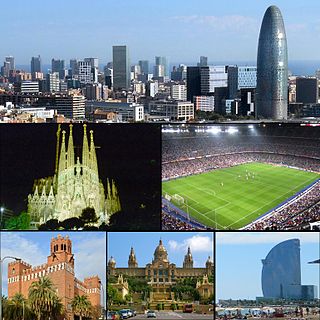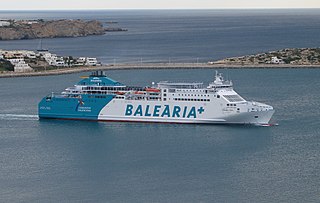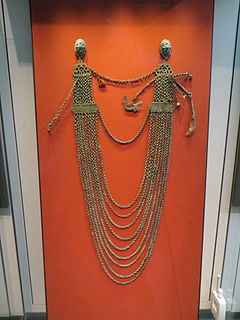
The history of Latvia began around 9000 BC with the end of the last glacial period in northern Europe. Ancient Baltic peoples arrived in the area during the second millennium BC, and four distinct tribal realms in Latvia's territory were identifiable towards the end of the first millennium AD. Latvia's principal river Daugava, was at the head of an important trade route from the Baltic region through Russia into southern Europe and the Middle East that was used by the Vikings and later Nordic and German traders.
This article provides an overview of the transport infrastructure of Latvia.
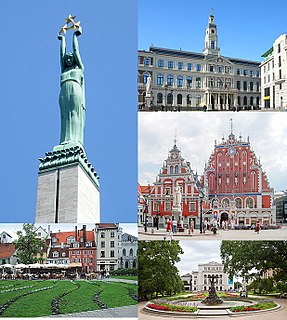
Riga is the capital and largest city of Latvia. With 637,827 inhabitants (2018), it is also the largest city in the three Baltic states, home to one third of Latvia's population and one tenth of the three Baltic states' combined population. The city lies on the Gulf of Riga, at the mouth of the Daugava river. Riga's territory covers 307.17 km2 (118.60 sq mi) and lies 1–10 m above sea level, on a flat and sandy plain.
MS Gabriella is a cruiseferry sailing on a route connecting Helsinki, Finland and Stockholm, Sweden for Viking Line. She was built in 1992 in Brodosplit, Croatia as Frans Suell for service with Euroway. Between 1994 and 1997 she sailed as Silja Scandinavia for Silja Line. Gabriella has sister ships Amorella in Viking Line fleet, Isabelle operated by Tallink, and a third one, Crown Seaways, operated by DFDS Seaways.

Mega Andrea is a cruiseferry owned and operated by Corsica Ferries Sardinia Ferries. She was formerly owned and operated by the Estonia-based Tallink as the MS Silja Festival, and used on their route connecting Riga, Latvia to Stockholm, Sweden. She was built in 1986 by Wärtsilä Helsinki Shipyard, Finland, for Effoa as MS Wellamo for use on Silja Line traffic. She was rebuilt in 1992 at Lloyds Werft, Bremerhaven, Germany as Silja Festival. In 2008 the ship was transferred from the Silja Line fleet to that of Tallink, but she retained her Silja-prefixed name. After being replaced by MS Isabelle on the Stockholm-Riga route in May 2013 she was chartered as an accommodation ship to Kitimat, British Columbia. She was then sold in early 2015 to Corsica Ferries.
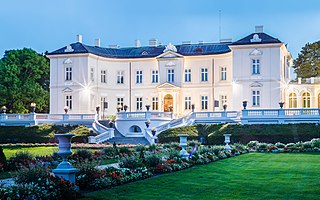
Palanga is a seaside resort town in western Lithuania, on the shore of the Baltic Sea. It is the busiest summer resort in Lithuania and has beaches of sand and sand dunes. Officially Palanga has the status of a city municipality and includes Šventoji, Nemirseta, Būtingė and other settlements, which are considered as part of the city of Palanga.
Tallink is an Estonian shipping company operating Baltic Sea cruiseferries and ropax ships from Estonia to Finland, Estonia to Sweden, Latvia to Sweden and Finland to Sweden. It is the largest passenger and cargo shipping company in the Baltic Sea region.

MS Bluefort is an accommodation vessel owned by the Canadian-based company Bridgemans Services Group LP. She was built in 1979 as a car/passenger ferry by Meyer Werft, Papenburg, Germany as Diana II av Slite for Rederi AB Slite for use in Viking Line's traffic. She has also sailed under the names Diana II, Vironia, Mare Balticum, Meloodia and ARV 1.

MS Vana Tallinn was a cruiseferry owned by the Estonian ferry company Tallink and operated on the line between Kapellskär and Paldiski. She was built in 1974 by Aalborg Skibsværft AS, Aalborg, Denmark for DFDS as MS Dana Regina, and has sailed under the names MS Nord Estonia and MS Thor Heyerdahl.

MS Regina Baltica is a cruiseferry owned by the Estonian shipping company Tallink. She was built in 1980 as Viking Song by Wärtsilä Perno shipyard, Finland for Rederi Ab Sally, one of the owners of the Viking Line consortium. She has also sailed under the names Braemar and Anna Karenina.

Finnlines Plc is a shipping operator of ro-ro and passenger services in the Baltic Sea and the North Sea. The Company is a part of the Grimaldi Group. Finnlines’ sea transports are concentrated in the Baltic and the North Sea. Finnlines’ passenger-freight vessels offer services from Finland to Germany and via the Åland Islands to Sweden as well as from Sweden to Germany. The Company has subsidiaries or sales offices in Germany, Belgium, Great Britain, Sweden, Denmark and Poland. In addition to sea transportation, the Company provides port services in Finland in Helsinki and Turku.
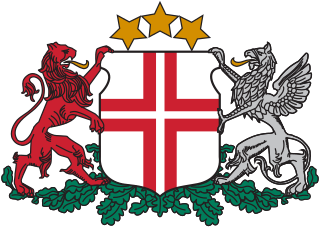
Latvian Naval Forces is the naval warfare branch of the National Armed Forces. It is tasked with conducting military, search and rescue operations, mine and explosive sweeping on the Baltic Sea, as well as ecological monitoring activities. The Naval Forces have participated in international NATO/Partnership for Peace operations and various exercises with great success. The main development priorities of the Naval Forces are to expand their activities within the Baltic States’ Ship Squadron BALTRON and to develop a Sea Surveillance System. They pay a great deal of attention to professionally specialized training and English-language teaching.

Port Link is a ro-pax ferry that was operated by Stena Line between Stranraer and Belfast.

The GNV Atlas is a Peter Pan-class cruiseferry currently owned and operated by the Italian shipping company SNAV. She was launched on 28 October 1989 by Schichau Seebeckwerft in Bremerhaven, West Germany as Olau Britannia for Olau Line.

MS Kaiarahi is a RO-RO ferry owned by Stena RORO currently operating on the Wellington to Picton interisland route between the North and South islands of New Zealand.
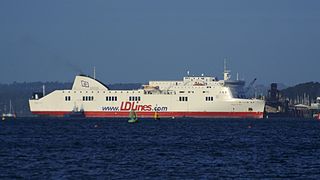
MV Connemara is a RORO passenger and freight ferry registered under the Greek flag of registry, currently on charter to Brittany Ferries from Stena RoRo. Connemara currently sails from Cobh, to Santander and Roscoff. From 2007 to 2010, she was operated by Balearia as Borja, then between 2010 and 2011 as Baltic Amber for AVE Lines and then DFDS Seaways, before subsequently spending 4 years on charter to LD Lines. She spent the majority of fall 2014 and 2015 on charter to Inter Shipping sailing from Algeciras, Spain, when she was then chartered by ANEK Lines, being replaced by Nova Star Cruises's Nova Star. The ship was renamed MS Asterion which comes from Greek Mythology of Asterion, the King of Crete.

LB or locally simply LB was a car and lorry ferry line that between 1955 and 1981 operated on the HH Ferry route between Helsingør (Elsinore), Zealand, Denmark and Helsingborg, Scania, Sweden. They were the first operator on this route to challenge the informal monopoly which DSB had enjoyed ever since 1888. And since 1630, competition at the route had only occurred between 1836 and 1840. The route had further been operated by the Danish National railways with train ferries since 1892, and since 1931 with a 50-50 support deal also with the National Swedish railways. Until LB challenged the informal monopoly.
Trave Line was a shipping line owned by "Stockholms Rederi AB Svea", and a part of the Linjebuss International AB LB/ SL/ TL car and lorry ferry concept. Trave Line operated on the long distance route between either Helsingborg, Scania, Sweden or Port of Tuborg, Copenhagen, Denmark and Travemünde, Schleswig-Holstein, Western Germany. There were no possibilities to drive off in the Port of Tuborg on southbound ferries, nor to drive onboard in Port of Tuborg on northbound ships.











